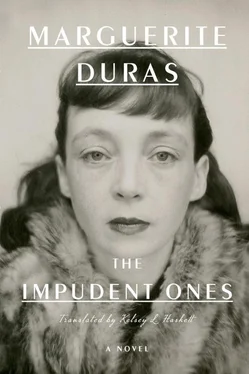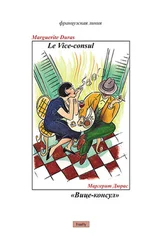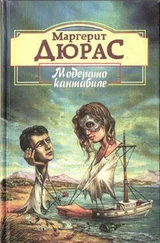The older brother’s brutal ascendancy over the family, first portrayed in The Impudent Ones , becomes a constant factor in later novels, in which the sister’s identification with him is nevertheless as powerful as her hatred of this abusive sibling. Her desire to see him dead in both The Impudent Ones and The Lover is played out in substitutionary form in La vie tranquille , which opens with the younger brother killing the uncle, who has also brought shame and ruin upon his family. The daughter’s perceived rejection by her mother because of an illegitimate pregnancy at the end of The Impudent Ones is hinted at elsewhere, but blows up into a catastrophic relationship in The Vice-Consul , where the pregnant daughter, expelled from her home, is forced into a life of begging and prostitution through her mother’s cruel rejection. Not only has this element of the story persisted in the author’s imagination, but it has intensified—through emotions that have obviously deepened with time. The absence of the father during the family’s entire stay at their domain of Uderan in The Impudent Ones is reinforced by his minimal role in the second novel and complete elimination in other novels, corresponding to the early passing of Duras’s own father, before her childhood stay at Platier, the family domain.
One of the most striking similarities in terms of character portrayal occurs in the person of Jacques, who reappears as the protagonist in Whole Days in the Trees (a short story, play, and film). The mirror image of Jacques in the first novel, the second Jacques has all the moral failings of the first, and an identical relationship with his mother (the same that appears in the other novels focused on the family). An inveterate gambler who is not above stealing from his mother in Whole Days in the Trees , he also demoralizes his family in The Impudent Ones through his reckless spending and continual need to beg for money from the rest of the family. In both stories he is unwilling to work, spends his time in a bar and dance hall, and insists on being in control of the people and events around him, even though he has no control over his own life. Despite his hardened character, he is the preferred child of his mother, who is ready to sacrifice her life and her other family ties to maintain an exclusive relationship with this son incapable of taking on the responsibilities of adult life. And yet, she occasionally questions her abnormally prolonged maternal role and muses in The Impudent Ones that “one should be careful of children who plunder everything one has”—words that could easily have been spoken by the mother of Jacques in Whole Days in the Trees .
This older brother shows up much later, of course, in The Lover , followed by The North China Lover , where his continued pillaging of the family is accompanied by a lurking threat of violence that kindles an even greater fear in his sister than that which appears in the first novel. It is not so much his gambling as his opium addiction that proves to be the underlying cause of his behavior in these later novels. Although fictionalized in many aspects, these semi-autobiographical novels relate nonetheless impactful emotions consciously or unconsciously registered by the author while encountering familial and other situations in life, which gradually evolve into story form. Duras herself claimed to have lived her life as a novel, and when queried about her life, she replied that her life was in her books—a statement implying both her intimate inner self and her more visible outer life.
Thus, when Maud fears her elder brother’s meanness and authority in The Impudent Ones , when the sister dreads the complicity of her brother with her mother who beats her in The Sea Wall , and when the narrator depicts the violence of the older brother in The Lover , who inflicts his reign of terror on both her and her younger brother, Duras seems to be transmitting a transformed, composite portrait of her life with her siblings, not necessarily as revealed in actual events, but as filtered through her subconscious. Duras’s second brother in The Impudent Ones corresponds to the one looked upon almost as her child in La vie tranquille (where the narrator holds a secret, passionate love for him), and to the adored “younger brother,” with whom the narrator has a similar relationship in the later semi-autobiographical novels.
Even more significant than the figure of the two brothers is the mother figure, who dominates the life of the female protagonist in all the novels in which the mother-daughter relationship is depicted. In The Impudent Ones , where this relationship first plays out, the strained relationship between the mother and daughter results from both the mother’s disproportionate love for the older brother and the daughter’s fear that her mother will learn of her relationship with George, which transgresses the family’s moral code (at least, for the daughter). These concerns carry over into each of the novels set in French Indochina, in which the mother’s treatment of the daughter becomes increasingly violent. In The Sea Wall , Suzanne is physically, verbally, and psychologically abused by the mother, who yells at her, accuses her of immorality, and beats her mercilessly at times, with the complicity of the brother. Using as a pretext that Suzanne has slept with the son of a wealthy Chinese businessman to obtain from him an enormous diamond (which, in fact, the mother has stolen from Suzanne), the mother takes out all her frustrations in life on her daughter, who becomes a scapegoat for her enormous failures. In The Lover , the daughter is also beaten and slapped around by her mother, who again is encouraged to do so by her older brother, and in The North China Lover this kind of treatment is mentioned in the dialogue.
In each of these novels an extreme tension develops between the daughter and the mother, even turning into a love-hate relationship in The Lover , but always caused by a deep sense of rejection on the part of the daughter, including Maud, at the end of The Impudent Ones , when she becomes pregnant with George’s child. The less violent relationship in this first novel returns to some degree in The North China Lover , where in a more fanciful way the author introduces surprising dialogues between the lover and the mother, whereby the mutual acceptance of the two seems to introduce a hidden desire for reconciliation on the part of Duras in relation to these two central figures portrayed in her works. Nevertheless, the plight of the daughter in each of the novels is much less than enviable when it comes to the mother-daughter relationship (as well as the relationship with the brothers) and produces an extreme and often overwhelming sadness in the daughter’s life.
Other parallels with future novels extend beyond family relationships. The figure of an unreported drowning victim appears in the first two works, with Maud, in the first novel, failing to mention the drowned woman she spots in the river, with serious consequences for the plot, and Francine, the main character in La vie tranquille , leaving undisclosed the fate of a man who drowns in the sea before her very eyes. At the end of The Lover , a young man also throws himself from an ocean liner into the sea, as the narrator and her family cross the ocean—seemingly unrelated events, but producing unsettling echoes.
Certain details of the relationship between Maud and George in The Impudent Ones are reflective of the relationship of the couple in The Lover , without the two sets of lovers being necessarily identical. In both cases, the young woman shows a sudden disinterest in her lover upon arriving at his place with the intent of giving herself to him for the first time, her interest being curiously deflected to her surroundings. However, it is only in the first novel that she is briefly seized with a keen sense of modesty and self-defense that she forces herself to overcome. Following that, the frustration of a relationship with no apparent future and seemingly devoid of love characterizes both of the couples.
Читать дальше









